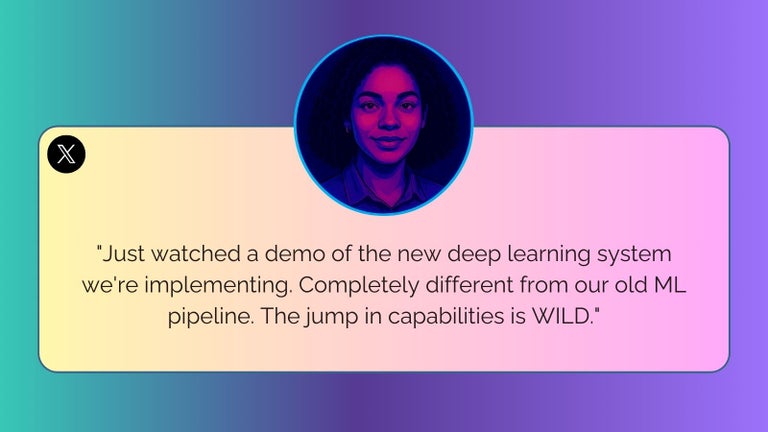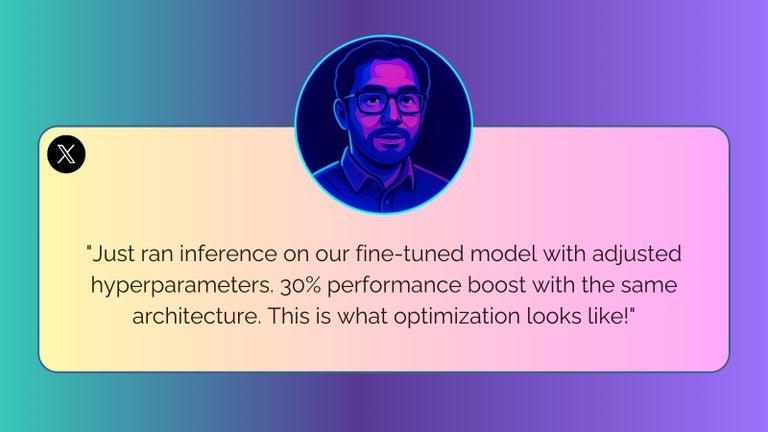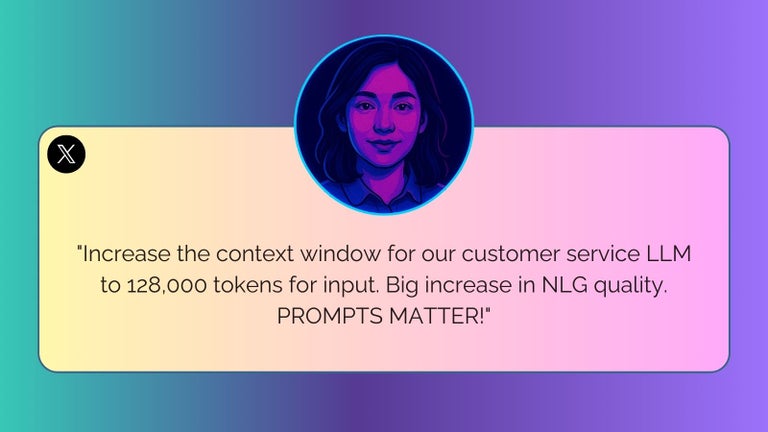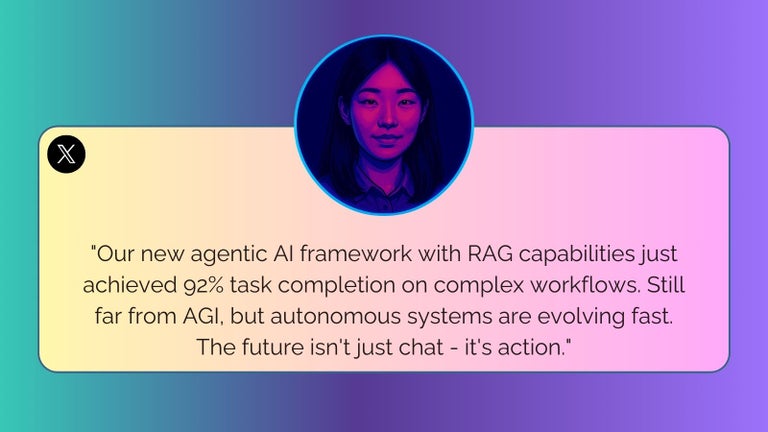Contents
- 1. The Beginning: What AI Actually Is
- 2. Meet the Machines: AI Models, Parameters How They Learn
- 3. Speak Fluent AI: The Language Behind AI Chatbots, LLMs, and Prompts
- 4. Beyond Text: How AI Sees, Thinks, and Predicts
- 5. Mastering the Build: Training Data, Tuning, and Copyright Chaos
- 6. From AI Chatbots to Agents: The Next Evolution in AI Lingo on X
- Update Your AI Cheat Sheet
Is your AI vocabulary becoming your career liability? While the tech elite openly share an image of our AI future on X, you're standing outside the velvet rope - fluent in yesterday's language. An AI cheat sheet is all you need to grab your seat at the table.
Anthropic just dropped their latest Claude 4 update on X. The thread EXPLODES.
You click, scroll, feel your stomach sink.
Retrieval-augmented generation. Multimodal reasoning. Agentic capabilities.
Every second comment might as well be written in hieroglyphics.
The gatekeepers of tomorrow aren't hiding their secrets. They're broadcasting the world's most important AI conversations directly on X.
No PR review. No exclusivity contracts. NO ENTRANCE FEE.
Yet you stand firmly on the outside. Finger hovering over terminology you recognize but don't understand. A spectator to conversations that WILL impact your professional life.
This is your career at a crossroads.
Defer to the future and have your role automated from beneath you. Become AI literate and join the new elite.
Harsh? The numbers tell the brutal story:
- Mass Evolution: 85 million jobs vanishing by 2025 while 97 million new AI-powered roles emerge
- Unstoppable Momentum: Organizations implementing generative AI more than doubled in 2023-2024 (33% → 71%)
- C-Suite Panic: 62% of leaders openly admit their organizations face an AI literacy gap
- Workforce Readiness: Nearly half (48%) the workforce would apply AI in their day-to-day if they understood how
The message couldn't be more clear.
Old jobs are vanishing. New AI-powered roles are emerging. Joining the AI conversation isn't optional.
Stop letting AI lingo on X act as the velvet rope to your AI-powered career. We're here to bring you into the conversation with the AI cheat sheet you've been waiting for.
1. The Beginning: What AI Actually Is

Deep learning... Machine learning... Artificial intelligence...
Wait - aren't they all the same thing!?!
This confusion is the first barrier that keeps you outside the AI conversation. Because if you don't know the difference between umbrella terms and specific implementations, you'll NEVER catch who's pushing the limits and who's just dropping buzzwords.
Here's what you need to know:
Artificial Intelligence (AI): The umbrella term covering all machine capabilities mimicking human intelligence. When someone just name-drops AI, they've told you almost nothing specific.
Machine Learning: Systems that learn patterns from data without explicit programming. Think Netflix recommendations getting eerily accurate because algorithms learned from your viewing patterns.
Neural Networks: Computing systems loosely modeled after the human brain. They process information through layers of interconnected nodes - like a brain's neurons - to make predictions or recognize patterns.
Deep Learning: Neural networks that process information in increasingly abstract layers. These are the artificial brains behind ChatGPT, Claude, Midjourney, and many of the other AI tools dominating your feed.
2. Meet the Machines: AI Models, Parameters & How They Learn

Another X post. Another mental short circuit.
Your colleague nods along. You smile uncomfortably.
That 30% performance boost sounds pretty good. But the rest? Might as well be Klingon.
Let's bridge the gap between bewildered observer and confident insider:
Algorithm: The recipe of specific steps a machine follows to learn, analyze, and make decisions to accomplish a task.
Model: The trained system that makes predictions after learning from data. ChatGPT isn't an algorithm - it's an artificial intelligence model.
Training: AI's expensive education. You don't program instructions - you expose the AI to examples (massive datasets) and let it learn for itself. This is why AI requires warehouses of computing power.
Fine-tuning: The specialized training that happens AFTER initial training. Think general medicine to heart surgeons. It's cheaper and faster than starting from scratch.
Inference: When AI actually does its job in the real world. After all the training and fine-tuning, this is when it's put to work.
Parameters: The individual knowledge points inside an AI's brain. More parameters = potentially smarter AI, but also more expensive to run. When tech leaders brag about parameter counts, they're essentially comparing brain sizes.
Hyperparameters: Human-controlled settings that direct HOW AI learns. You set these BEFORE training begins - like choosing game difficulty before pressing start.
Architecture: The blueprint for how an AI system is structured internally. Different architectures excel at different tasks - some are better for language, others for images, others for predictions. Architecture changes are MAJOR overhauls.
3. Speak Fluent AI: The Language Behind AI Chatbots, LLMs, and Prompts

This X post has been at the top of your feed all morning. The CEO of a rising AI startup you follow just dropped it.
8.2K likes. 1.3K comments. 3.4K reposts.
Clearly, something MAJOR just happened.
Let's decode it:
Natural Language Processing (NLP): AI's ability to understand human language with all its messiness, ambiguity, and cultural context. It's why you can type 'show me Q3 sales' instead of lines of code.
Natural Language Generation (NLG): AI's ability to produce text that sounds human. It's the difference between 'Data analysis complete. Results negative.' and 'I've looked through everything, and good news! There's nothing concerning in your test results.'
Large Language Models (LLMs): The superstar AI text systems that power ChatGPT, Claude, and every conversational AI worth mentioning. These are the multibillion-dollar brains behind the AI revolution.
Token: How AI measures text. One token ≈3/4 of an English word. When companies price their AI services or measure performance, they count tokens, not words. A 100K token context window means the AI can remember roughly a medium-sized novel during your conversation.
Context Window: An AI's working memory - how much text it can keep in mind at once. Early AI could only remember a few sentences (imagine talking to someone with goldfish memory). Today's advanced systems can process book-length conversations.
Prompt Engineering: The dark art of talking to AI to get exactly what you want. The SAME AI can produce radically different results depending on how you ask. Bad prompts = garbage outputs. Expert prompts = clean output.
4. Beyond Text: How AI Sees, Thinks, and Predicts

So you've mastered the basics. You know your LLMs from your NLP. Tokens from prompts.
But AI isn't just text anymore.
Let's understand how AI is entering our physical world:
Computer Vision: AI's ability to ‘see’ and understand images and video. It powers everything from facial recognition on your phone to quality control in manufacturing to medical imaging analysis.
Pattern Recognition: The foundation of how AI learns. It's how systems identify recurring structures or relationships in data. In images, it spots edges, shapes, and objects. In business data, it finds trends and correlations humans might miss.
Multimodal Models: AI systems that can process multiple types of information (text, images, audio) simultaneously. They're like humans who can both read a menu AND see the food photos. Single-mode AI is becoming obsolete - multimodal is where the value explosion is happening.
Image Recognition: AI identifying specific objects, scenes, or features in pictures. ‘That's a dog’ or ‘That's a malignant tumor’ - both are image recognition at work.
Facial Recognition: Specialized image recognition that identifies human faces. It's why your phone unlocks when you look at it and why security cameras can track specific individuals.
Latency: The delay between input and response. Low latency means the AI responds almost instantly - critical for real-time applications like self-driving cars or live video analysis.
Synthetic Data: Artificially created information used to train AI when real data is limited, sensitive, or expensive to collect. Think generating thousands of simulated medical scans to train diagnostic AI.
Generative Models: AI that creates new content rather than just analyzing existing data. This powers everything from image generators like DALL-E to synthetic video creation.
5. Mastering the Build: Training Data, Tuning, and Copyright Chaos

Wait. Why are AI leaders on X suddenly arguing about licensing, consent, and terms of service?
Here's the truth: AI isn't just algorithms and models.
It's data. And who owns that data matters.
A quick Google search will show a long list of data and security concerns. Meta’s use of pirated shadow library LibGen to train GenAI models. Allegations of China based Deep Seek’s unauthorized data transfer through OpenAI’s API. A new GenAI copyright infringement suit lobed against OpenAI for data scraping - a first-of-its-kind lawsuit in India.
You don’t need to look far to see AI and data is a serious concern.
If you're planning on using AI for work, you HAVE TO understand the legal and ethical foundation they're built on.
Here are the terms you need to understand:
Training Data: The information AI systems learn from. Everything an AI knows comes from its training data - including biases, limitations, and potentially copyrighted material.
Data Scraping: Automatically collecting large amounts of data from websites. It's how many AI companies built their training datasets, often without explicit permission from content creators.
Fine-Tuning: Customizing a pre-trained AI model for specific tasks using smaller, targeted datasets. It's the difference between generic AI and AI that excels at your specific business needs.
Adapters: Small, trainable modules added to frozen pre-trained AI models. They allow customization without retraining the entire system, preserving the original while adding specialized capabilities.
Terms of Service: The legal agreements governing how AI systems and their training data can be used. Breaking these can mean lawsuits, banned accounts, and PR disasters.
Licensed Datasets: Collections of content with clear usage rights for AI training. Using these means fewer legal headaches but often more cost or limitations.
Intellectual Property (IP): The legal rights to creative works and inventions. AI trained on copyrighted material raises complex questions about ownership of both the training data and the AI's output.
Synthetic Data Generation: Creating artificial but realistic training examples to avoid copyright issues or augment limited datasets. It's becoming essential as legal scrutiny of training practices increases.
6. From AI Chatbots to Agents: The Next Evolution in AI Lingo on X

The conversation on X has already evolved beyond bare-bones prompt-and-response style AI.
Today's thought leaders are discussing systems that dig through your prompt, reason through next steps, make decisions AND take action.
More autonomous. More impactful than ever.
The shift from AI that talks to AI that does is looming. Let's decode AI's frontier terms:
Hallucinations: When AI confidently (and often convincingly) generates false information. Reducing these through techniques like RAG is crucial for business-critical tasks.
RAG (Retrieval-Augmented Generation): AI that actively searches external information (like your knowledge base) before generating responses. It's like having a research assistant who checks facts before speaking, adding context, reducing hallucinations, and increasing response accuracy.
Autonomous Systems: AI that can operate independently to complete complex tasks. Self-driving cars, robotic process automation, and AI assistants that schedule meetings without supervision are all autonomous systems.
Agentic AI: AI systems designed to operate with some level of independence, making decisions and taking actions without human intervention or supervision at every step.
Workflows: Multi-step processes the AI manages from start to finish. As AI becomes more agentic, handling entire workflows rather than single tasks becomes the competitive differentiator.
AI Agent: Specific software that takes autonomous actions based on goals rather than just responding to prompts. It's the shift from AI that talks to you to AI that does things for you.
Task Completion Rate: The percentage of assignments an AI can successfully finish without human intervention. It's becoming THE key performance metric as AI moves from conversation to action.
AGI (Artificial General Intelligence): The hypothetical AI that can perform any intellectual task a human can. Current AI is narrow (good at specific tasks). AGI would be broadly capable across domains. It's both the holy grail and boogeyman in AI circles.
Update Your AI Cheat Sheet
The divide between AI observer and AI participant isn't knowledge. It's vocabulary.
Because you can't leverage what you don't understand.
Top AI thought leaders are sharing their biggest and boldest ideas FREELY. But until you master the right AI lingo on X, you'll stay locked firmly on the outside.
This AI cheat sheet is your introduction to the conversation.
Use it as a foundation. Add new terms as they emerge. Make this your living dictionary.
It's time to join in.
Still scrolling past AI conversations you don't understand? The next breakthrough in your AI workflow might be one post away. Use this AI cheat sheet and join the conversation.








